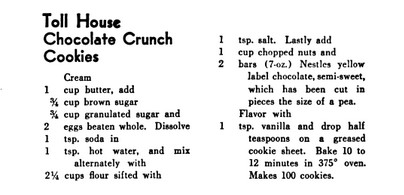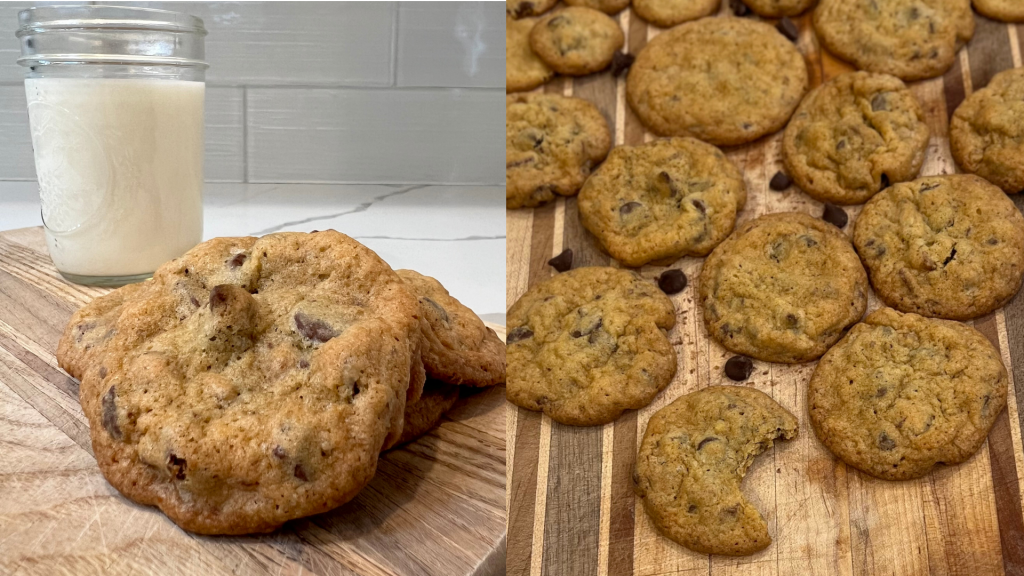by Lauren Gray, Reference Librarian
From your grandmother’s kitchen to a well-stocked Girl Scout table, there’s something about cookies. Cookies make your taste buds dance and your fingers reach out to steal just one more from the jar. They are the quintessential American treat, encapsulating all that is quick and convenient: they mix easily, they bake quickly, they don’t require wrappers or refrigeration, and they taste wonderful. But cookies tell us more about ourselves than what we read on the label: they are a glimpse into family rituals and cultural traditions, sometimes passed down over generations. Every beloved cookie has a story.
Americans are a nation of prodigious cookie eaters (we eat on average about 200 cookies a year)[1]. The most famous American cookie of all? The chocolate-chip cookie, of course. It is arguably the best and certainly the most popular. We like chocolate chippers so much we’ve even made a cereal out of them. Surprisingly, however, they are a relatively new invention. First mixed, scooped, and baked by Ruth Wakefield at her Toll House restaurant in Whitman, Massachusetts, the recipe was originally published in 1938 as the “Toll House Chocolate Crunch Cookie.”[2] Nestlé soon swooped in for the rights to the cookie, and the rest, as they say, is history.
Chocolate-chip cookies soon became America’s darling, a sweet bite amidst the Great Depression. Just a few years later, they appeared in care packages to New England troops sent abroad during the Second World War. By the 1950s, copycat chocolate-chip cookies popped up in supermarkets across the U.S., produced by companies like Pillsbury and Nabisco. Variations appeared, some with margarine, others with macadamia nuts; a few with white chocolate, others with M&Ms. Ben and Jerry’s put cookie dough in ice cream in 1984, and their Chocolate Chip Cookie Dough Ice Cream remains one of their most popular flavors.[2] As Jon Michaud posited in his New Yorker article on the history of the cookie, “In its ability to absorb such a heterogeneous list of ingredients and still retain its identity and appeal, the chocolate chip cookie is representative of the aspirations of the country for which it has become the preferred treat.”[2] The chocolate-chip cookie quickly became as American as apple pie.

Chocolate “chippers” (our family’s probably unoriginal nickname for them) were a steady favorite in our house during the 1980s and ‘90s. My mom baked them so often that my aunt bought her a special cookie-making bowl made of heavy beige ceramic and decorated with thick blue stripes. My aunt was clearly on to something, because I’m pretty sure I’ve seen versions of that bowl in antique stores across the country.
Probably like many Americans, we followed the recipe on the back of the Nestlé Toll House 12oz bag of semi-sweet morsels, which was adapted from Mrs. Wakefield’s original recipe. The ingredients and measurements are the same as the original, with a couple notable exceptions. For example, Nestlé no longer sells semi-sweet chocolate by the bar for you to chop into “pea-size pieces” (which Mrs. Wakefield swore by). She also instructed you to dissolve the baking soda in hot water before mixing it intermittently with the flour.
In my family, we used butter, but the omnipresent ‘80s Crisco occasionally made an appearance. I remember waiting ages for the butter to soften, impatiently pressing the back of my fork into the hard stick, its pliable metal tongs yielding against my thumb (I ruined more forks that way). Creaming the butter and sugar was the hardest part – even when I had begged to be allowed to make the cookies, my mom always ended up creaming the butter, bowl squeezed under one arm, her right hand steadily working the butter into the sugar. As an adult, I’m lazy and use a hand mixer, but my mom was a fork-purist. I wonder if that’s how she achieved the perfect texture and spread every time, not too greasy, not too cakey.
We used a mix of white sugar and light brown sugar in equal parts (the dark brown sugar was too reminiscent of molasses, though Mrs. Wakefield didn’t specify which type in the original recipe), and we always added the eggs together instead of beating them in one at a time (or beaten together prior to going in, as in the original). Then came the vanilla. My mom was heavy-handed with the McCormick – she tipped the bottle over the teaspoon and let it run over the edge for a solid 1-1000. She never seemed to worry about an imbalanced liquid to dry ingredient ratio.
If memory serves, mom would switch out the fork halfway through mixing in the flour. She had a designated oversized and sturdy ‘cookie spoon’ that we only used for baking, and it was always on hand to do the final mix of dough and chocolate chips. The recipe calls for a ludicrous amount of chips, and this is where we deviated from the measurements. We are parsimonious chip people, even today – the elegant simplicity of the chocolate chip cookie is in its rich vanilla dough to chip balance. Too much dough and it gets monotonous; too many chips and it may as well be dough-flavored fudge. We poured the chips by sight, occasionally just a small squeeze of the bag. We gently folded them in, careful not to overmix the flour. In the original recipe, Mrs. Wakefield also called for nuts, and the Nestlé bag lists them as “optional.” In our house, they were “optionally” excluded. Once mixed, we would take a small spoon from the drawer and measure out equal-ish balls of dough, putting them on the gray metal baking sheet, three to a row at alternating angles. (Mrs. Wakefield’s recipe called for ½ teaspoon balls, gently formed by moist fingers, which look ludicrously small to modern eyes.)
Baking time was our only real disagreement. My mom loved the soft middles and squishy centers, when cookies came out just shy of underbaked. And I appreciated that – at first. Then my dad’s genes kicked in. I quickly developed an appreciation for crunchy brown edges and stiff, unyielding crusts. The over-caramelization of sweet dough melted on my tongue. So, we compromised. One sheet went in for 9-10 minutes, the next sheet for 12-13. There’s no crying over cookies. (The original recipe called for the ½ tsp. size balls to be baked at 375 degrees for 10-12 minutes. Modern ovens must run hotter, because the only thing you get at the end of that are burned little hockey pucks. I suggest checking them at six minutes.)
Mrs. Wakefield baked her cookies to accompany ice cream, which perhaps accounts for the small size. We baked ours to eat, hot and crumbly from the oven, snatching them off the rack before they had time to set. It was in the kitchen that I learned the best lessons from my mom, which she in turn had learned from her mom. Baking cookies connected me with the grandmother I never knew. When Mrs. Wakefield dedicated her first cookbook to her own mother, “whose encouragement and confidence have meant more than mere words can express,” I think she was hoping that her recipes would bring families together.
Growing up, neither my mom nor I knew that the original chocolate chip cookie originated in Massachusetts. When doing research for this blog post, I was sad to learn that the original Toll House restaurant, which the Wakefields ran from 1930 to 1967, was lost to a fire in 1984. I was equally sad to find that the MHS doesn’t hold her original recipe book, published in 1931, or any of the revised editions published thereafter, which include the famous cookie. If anyone has a copy, let us know, we’d be glad to take it off your hands.[3] We’ll bake you a batch of cookies for it. Having tested a batch of her original Toll House Chocolate Crunch Cookie, I can confirm, they are pretty darn tasty. I even liked the nuts.

P.S.
If you want to try your hand at a batch of the original “Toll House Chocolate Crunch Cookie,” you can find the recipe in several places. The 1940 version of Ruth Wakefield’s Toll House Tried and True cookbook is available online for free through HathiTrust. In 2018, the New York Times published a short obituary on Mrs. Wakefield, including the original recipe, in their “Overlooked No More” column, which documents the stories of remarkable but historically overlooked people.[4]
[1] https://wror.com/2023/08/07/how-many-cookies-does-the-average-american-eat-each-year/
[2] “Sweet Morsels, A History of the Chocolate-Chip Cookie” by Jon Michaud, The New Yorker
[3] The MHS has plenty of other cookbooks, both published and unpublished. Visit our catalog, ABIGAIL, to learn more.
[4] “Overlooked No More: Ruth Wakefield, Who Invented the Chocolate Chip Cookie,” by Sam Roberts, New York Times, originally published March 21st, 2018.

